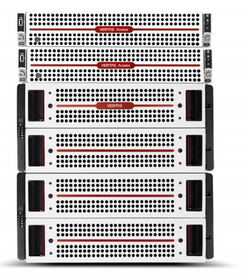- VOX
- Technical Blogs
- Veritas Perspectives
- When is an appliance more than just an appliance?
When is an appliance more than just an appliance?
- Subscribe to RSS Feed
- Mark as New
- Mark as Read
- Bookmark
- Subscribe
- Printer Friendly Page
- Report Inappropriate Content
The traditional acquisition model for enterprise storage infrastructure is to outright purchase the hardware and software together from a specific vendor as an appliance. The benefits of purchasing a single package include a central point of support and getting a tuned and tested solution. But those benefits can actually lead to a disadvantage—namely that it requires purchasing vendor-specific hardware that locks customers into that vendor’s hardware and its corresponding hardware release cycles. Being locked into a specific refresh cycle can limit flexibility in deploying new technology that might improve costs or performance, or preclude using hardware that the customer feels provides a more effective solution.
Software-defined storage vs. an appliance
Software-defined storage (SDS) is becoming a widely-accepted alternative to the traditional acquisition model. SDS decouples the software from the hardware, allowing customers to deploy storage software on the hardware of their choice. SDS provides deployment flexibility, lower hardware costs, organizational agility, and easier, more affordable growth. It’s perfect for organizations that have sufficient time and IT resources to support a “do-it-yourself (DIY)” deployment model.
However, when storing their most valuable assets, the need for a “complete” solution—a tested, tuned and supported solution stack—can outweigh the benefits of SDS (since an SDS deployment by definition means a DIY approach). An organization may need additional resources sooner than it is practical to do an SDS deployment, or they may lack the resources to test and tune an SDS solution on their own hardware.
Ideally, customers need an end-to-end packaged solution, with the flexibility of SDS but without being locked into a specific vendor’s hardware agenda.
When is an appliance more than just an appliance?
It’s in Veritas’ DNA to develop high-quality software that provides industry-leading functionality. Our storage solutions are based on a “software-first” (i.e., software-defined) approach, where the storage management software is decoupled from the underlying hardware. The decoupling gives customers the freedom to choose the hardware that best suits their infrastructure, performance, and cost requirements. It’s a great solution for customers who are used to deploying thei
A Veritas appliance (we call it a “Software-defined Appliance”) gives our customers the best of both worlds: the appliance comes with the appropriate Veritas software licenses pre-installed, and they can deploy a solid, tested, optimized and fully supported solution stack that can be up and running quickly. But, (an important “but”), the software is still decoupled from the hardware.
Enter the Un-appliance: The best of both worlds
That decoupling of hardware and software provides a solution unique in the industry: quickly deploy a proven turnkey solution while retaining the flexibility of replacing the hardware “underneath” the software licenses in the future. The customer’s software licenses are not tied to the Veritas-supplied hardware—the customers are free to deploy those licenses on compatible hardware of their choice.
At a future point, customers can choose a DIY replacement of hardware—for example, to rebalance hardware resources across their infrastructure, or upgrade to new technology—or they can choose to upgrade to the next-generation Veritas appliance (Table 1). It’s the best of both worlds; we call it “The SDS-appliance.” (Maybe we should call it the Un-Appliance!)
To learn more, read the latest from our Appliance announcement here.
You must be a registered user to add a comment. If you've already registered, sign in. Otherwise, register and sign in.
- Securing Data and Infrastructure: A Comprehensive Approach in Protection
- Understand, Plan and Rehearse Ransomware Resilience series - Day 1 in Protection
- Understand, Plan and Rehearse Ransomware Resilience series - Access and Improve in Protection
- Secure the keys to your data kingdom in Protection
- Find out what’s new in Veritas NetInsights Console (System Health Insights) in Protection


